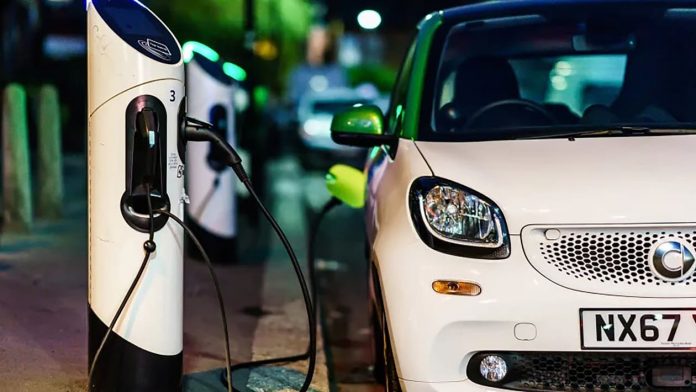The Department for Transport has revealed its plan to advance the rollout of public charge points for electric cars, with a new £450m fund that local authorities can use to expand charge point provision in their areas.
The new money announced today is on top of the previously announced £950m Rapid Charging Fund which supports the rollout of 6,000 high powered chargers across the motorway network. It should mean drivers have access to around 300,000 public chargers by 2030, the DfT claims, a number that’s five times the number of fuel pumps in UK filling stations.
In its statement announcing the plan, the DfT said the government’s aim is to expand the UK’s charging network so it’s robust, fair and covers the whole country.
“No matter where you live – be that a city center or rural village, the north, south, east or west of the country, we’re powering up the switch to electric and ensuring no one gets left behind in the process,” said Transport Secretary Grant Shapps.
As part of the new plan, the DfT has also announced that it will become mandatory for charge point operators to provide real-time data about their charge points and prices, as well as accepting contactless payments and meeting a 99 percent reliability standard.
No national direction for charger rollout
There is, however, no national direction about how the rollout should be implemented, with the DfT leaving local authorities to develop individual schemes. As a result, the Society of Motor Manufacturers has renewed its call for a nationally coordinated infrastructure campaign, including binding targets that would match the targets the government has placed on car makers to end production of internal combustion-engined cars. “If industry and consumers are to have the certainty they need to invest, commensurate and binding targets must be set for infrastructure provision,” said SMMT chief executive Mike Hawes. “Deployed nationally and at pace, this expansion would give drivers confidence they will be able to charge as easily as they would refuel, wherever they are.”
Under the government strategy, there is a commitment only to provide an online ‘knowledge hub’ setting out all its current guidance to support local authority installations. The DfT is also earmarking up to £50million of the new £450million Local Electric Vehicle Infrastructure (LEVI) fund for councils to hire staff to help with strategy and planning. The rest of the money is to be spent on ‘projects such as EV hubs and innovative on-street charging, so those without driveways don’t miss out on cleaner transport’, the DfT says.
The strategy has been cautiously welcomed by the AA. “The Government does appear to recognize that ease of use, reliability, slow roll-out for those without home charging and improving charging on motorways, are all essential,” said spokesman Edmund King. “We would like to see urgent action in all of these areas plus we have also called for more focus on charging solutions in rural locations, improvements to the customer experience in terms of safety at charge points in dark, isolated areas and accessibility for disabled drivers .”
SMMT called for Government leadership on charging
Just one day before the DfT’s charging infrastructure announcement, the Society for Motor Manufacturers and Traders (SMMT) had called for a “universal right to charge” as the ratio of public charge points to electric vehicles dropped by half in the previous 12 months. There is now one charge point for every 32 plug-in vehicles, compared to one for every 16 cars in 2021.
Mike Hawes, chief executive of the SMMT, said there is now a greater focus on “charge anxiety” than range anxiety, as the UK’s electric car charging infrastructure struggles to keep up with strong EV sales.
Hawes asked the government for “more investment in standard public charging”, with a greater focus on “on-street charging” for those unable to top up their cars’ battery at home. He said that if the UK is to meet its targets for 2030 and beyond, drivers need “the right chargers, in the right places, ahead of time.”
While as many as one in 20 cars registered so far this year is electric – up from one in 1,700 in 2011 – the SMMT suggests there could be as many as 9.3 million EVs on UK roads by the end of the decade. A figure that will almost double to 18.4 million in 2035.
Hawes and his team want to see the disproportionate ratio of cars to chargers addressed via a nationally coordinated infrastructure campaign. They say binding targets are required for infrastructure roll-out, which would match the targets being imposed on the car industry to accelerate the EV switchover. The DfT, however, is taking a different route.
Fleet and company car sales fueling EV boom
In a statement at the 2022 SMMT Electrified conference in London, which aims to bring together industry stakeholders and government to accelerate the transition to net zero, the organization also highlighted that private motorists bought only a third of the new plug-in models sold in 2021 , with the majority going to fleets and company car drivers.
Businesses see big tax benefits, while incentives for private drivers to switch to EVs are being withdrawn. As a result – and despite demand far outstripping supply – the SMMT says EV adoption in the UK is falling behind some European nations.
“The UK automotive industry has invested massively (£10.8bn in EV and battery production) during Britain’s first electric decade,” Hawes said. “As we enter the second, the stakes are higher, but mandates on manufacturers alone will not drive the market.”
Click here for our list of the best electric cars on sale right now…

